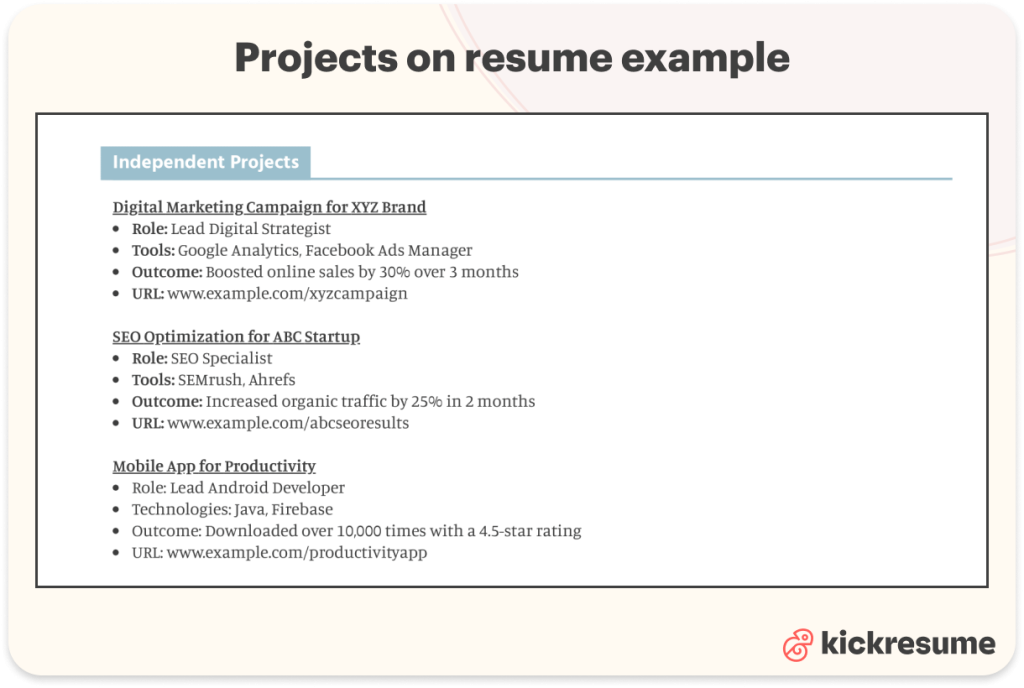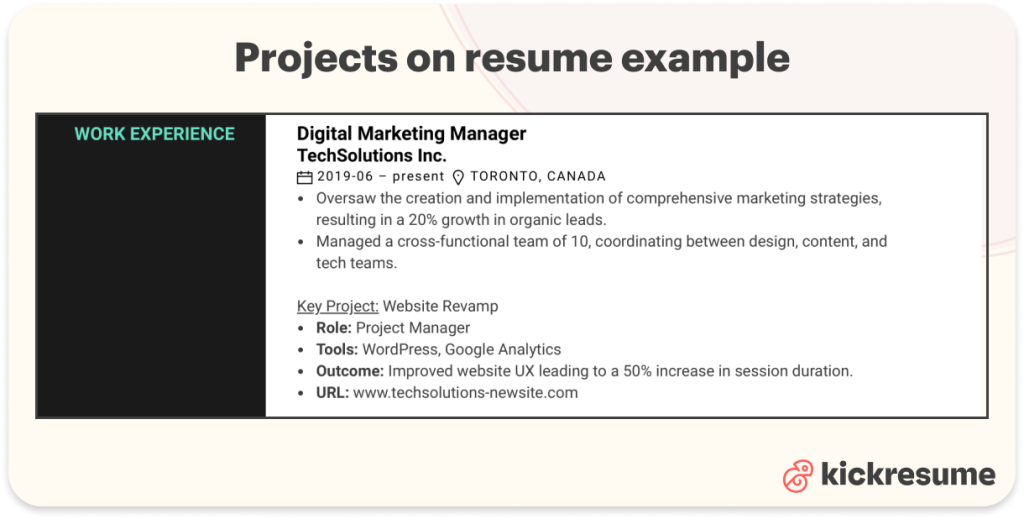Including projects on a resume isn't a common practice. Yet, it's a game-changer that can set you apart from the crowd. Why?
It showcases your real-life expertise, offering tangible proof of your skills and capabilities.
But, what are projects on a resume? Projects on a resume is a separate section in your resume where you list any kind of projects you've worked on. These can be academic, personal, work-related, freelance projects, etc.
Including these on a CV highlights your initiative and expertise and gives recruiters a glimpse into your hands-on experience, allowing them to see your capabilities in action, not just as words on paper.
In this article, we go over:
- What are projects on a resume?
- What projects to put on a resume?
- How to list projects on a resume?
Plus, we show you examples of a 'projects' resume section ready for you to copy and paste into your own CV.
What are projects on a resume?
Projects on a resume is basically like your standard sections on resumes: Education, Work Experience, or Skills. This section acts like a visual portfolio embedded in your CV, detailing the diverse projects you've engaged in.
So, how does this section look? Well, it includes a concise description of each project, outlining your role, the skills applied, and, importantly, a link for the recruiter to see the actual work or results.
Imagine a recruiter clicking through to see your coding project on GitHub or a marketing campaign you designed—impressive, right?
Why include a projects section in your resume?
A projects section on your resume offers insight into your hands-on experience and drive.
Here's why adding a projects section to your resume can benefit you:
- Stand out from the crowd. Not many candidates utilize this section. Including it can differentiate your resume from the stack, making it more memorable and engaging.
- Shows hands-on experience. It’s one thing to list your skills; another thing to show them in action. This section lets your work speak for itself, providing tangible evidence of your capabilities.
- Demonstrates initiative. Listing projects, especially personal or voluntary ones, showcases your motivation, dedication, and proactive nature. It tells employers you don’t just wait for assignments—you seek opportunities to learn and grow.
- Diversifies your profile: Regardless of whether you’re a fresh graduate or a seasoned professional, projects can show a range of skills and experiences, making your profile richer and more versatile.
In essence, a projects resume section serves as proof of your skills and experiences, allowing recruiters a glimpse into your practical expertise. Plus, it adds something a little extra to your resume.
Alternatively, if you already have a great LinkedIn profile with your projects included your can try the easy LinkedIn to resume converter and you'll have your resume ready in no time.
Types of projects to show on your resume
The projects section of your resume can be as diverse as your experiences. The key is to pick projects that best represent your skills, dedication, and expertise in a potential job role.
Here, we dissect some of the most impactful types of projects you might consider including:
1. Personal projects on resume
Personal projects can be incredibly telling. They often arise from passion, self-motivation, and a genuine desire to learn or create.
These projects can be an excellent indicator of your ambition, dedication, and self-learning capabilities.
Personal projects can include (but aren't limited to):
- Personal blog talking about industry trends
- DIY crafts website you started
- App developed during weekends
- Photography portfolio capturing unique perspectives
- E-commerce site you set up and handled
2. Academic projects on resume
For those fresh out of school or even industry professionals, academic projects can show both theoretical understanding and its practical application.
They show your ability to apply classroom learning to real-world scenarios, cooperating with peers, and see an assignment through to completion.
Here are examples of academic projects you can include on your resume:
- Research paper on a critical industry challenge
- Science fair project with a novel idea
- Community initiative led by your university
- Multidisciplinary capstone project
- Simulation model showcasing problem-solving
3. Python projects for resume
With the increasing prominence of Python in diverse fields, showcasing Python projects can be a game-changer for both tech-centric roles and those that lean less technical.
It highlights your proficiency with one of the world's most versatile programming languages and your ability to solve problems using tech.
And, using platforms like GitHub can be an excellent way to provide tangible proof of your code and your commitment to collaborative coding.
Steps to list Python projects on resume:
- Highlight the problem: State the challenge.
- Elaborate on the tools: Mention Python tools or frameworks.
- Use GitHub: Share a link to the repository to showcase the code.
- Impact and results: Summarize the outcomes.
Below are examples of what types of Python projects you can include:
- Data analysis tool using Pandas and Matplotlib.
- Automation script streamlining tasks.
- Web scraper for market insights.
- Customer service chatbot.
- Game using Python's Pygame library.
4. Freelance projects on resume
Freelance work showcases adaptability, entrepreneurship, and the ability to manage client needs.
Examples:
- A brand strategy crafted for a startup.
- Website design for local businesses.
- Social media campaigns executed for multiple clients.
- Content creation for diverse industries.
- A consulting stint to optimize business processes.
5. Volunteering projects on resume
Volunteering reflects dedication, empathy, and often, leadership and teamwork.
Examples:
- Organizing community clean-up drives.
- Fundraising campaigns for a local charity.
- Teaching initiatives in underprivileged areas.
- Disaster relief work in affected regions.
- Setting up and running awareness campaigns on social issues.
How to list projects on a resume
When it comes to listing projects, there's a choice to make:
A. Do you create a separate section? Or
B. Weave them into existing sections?
A good rule of thumb? If you have three or more projects, consider creating a separate section.
Both integrating projects into existing sections and creating a separate section have their merits.
Steps to list projects in a separate projects section:
- Choose the right title. Opt for titles like "Projects," "Independent projects," or "Freelance projects" based on your projects' nature.
- Include details. Mention your specific role, the outcomes achieved, and any technologies or tools you've used.
- Quantify. Using numbers like "boosted website traffic by 20%," often means more to recruiters.
- Include URLs. Add a direct link to your project. You can use a hyperlink or provide the full URL. However, be mindful with hyperlinks. Some Applicant Tracking Systems (ATS) might strip the hyperlink, leaving only plain text.
Steps to list projects within an existing resume section:
- Integration. Incorporate project details into your Work experience or other relevant sections (e.g., Education).
- Use action verbs. Begin with verbs like "developed," "initiated," or "spearheaded" for added vigor.
- Include URLs. If available online, share links to your project, ensuring potential employers can view your work directly.
- Consistency. Ensure your formatting matches the rest of your resume for a unified look.
Whichever method you opt for, ensure your projects are presented to best highlight your experience and accomplishments.
Projects on resume examples
Sometimes, it's easier to show rather than tell. To provide a clearer outlook, we provide a few examples to get you started with including projects on your resume.
Below is an example of how a separate projects section on a resume might look for someone in the marketing field:

Sometimes, blending projects into your work experience offers a better view of your contributions to a particular role.
Here's an example of how you can seamlessly integrate a significant project within the "Work Experience" section:

Note: The following resume examples were created using Kickresume's resume builder.
Formatting tips for a projects resume section
In the world of resumes, presentation matters as much as content.
A well-formatted projects section can elevate your resume, making it more digestible and engaging for recruiters.
Here are some formatting tips to ensure your projects section shines:
- Use bullet points. Bullet points break up text, making your achievements easier to skim and digest. It also looks tidier and more organized.
- Consistency in formatting. Whether it's the font, size, or layout, ensure it matches the rest of your resume. Consistency signals professionalism.
- Positioning the projects section. If your projects are highly relevant to the job you're applying for, place this section near the top of your resume. But, if they're more extra, position them towards the end.
- Prioritize your projects. Always lead with your most relevant projects. If you developed a game-changing marketing strategy, it should come before that small side project you did 3 years ago.
- Including URLs. When adding URLs to showcase your work, make sure they're neat. You can use hyperlinks, but be careful. Some ATS may strip out hyperlinks, leaving plain text. Always ensure the plain text URL is understandable and doesn't break when the hyperlink is removed.
Remember, the goal is to make your projects section as readable and impressive as possible, guiding the recruiter's eye to your most noteworthy accomplishments.
Key takeaways: Projects on resume
The job market is as competitive as ever, and standing out is paramount.
One sure way to make your resume stand out is to include projects you've worked on in your CV. It adds a little something extra to your resume and provides a real-life look into your skills.
Create a separate projects section if you have more than 3 relevant projects to showcase. If not, you can include the projects in other resume sections, like the work experience.
Don't forget to give the project a clear name, mention what your role was, what the outcome was, and include a URL.
A projects section can be the x-factor that propels your resume to the top of the pile. It paints a fuller picture of who you are as a professional, not just what you've done, but how you've approached and executed real-world challenges.
FAQ: Projects on resume
- What is a projects section?
A dedicated space on your resume where you showcase the hands-on work you've undertaken. It's not just about what you say you can do; it's about what you've actually achieved.
- What types of projects can I include on a resume?
There's versatility here. From personal passions to academic assignments and from freelance gigs to tech endeavors like Python tasks — each project type tells a story of your dedication and skill.
- How to list projects on a resume?
There are two main paths. Either as a separate section or integrated within existing sections like work experience. A standalone projects section could be the way to go if you've got a hefty list, say three or more substantial projects.
- What are the benefits of a projects section?
1. It differentiates you from a sea of similar resumes.
2. Offers tangible evidence of your skills in action.
3. Demonstrates initiative and proactiveness.
4. Adds depth and versatility to your professional story.



